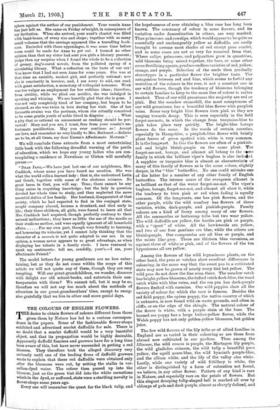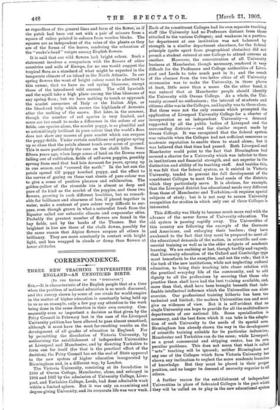THE COLOURS OF ENGLISH FLOWERS.
THE desire to obtain flowers of colours different from those given them by Nature has led to a curious correspon- dence in the papers. Some of the fashionable flower-shops exhibited and advertised scarlet daffodils for sale. There is no doubt that a scarlet daffodil would be a very beautiful object, and that its propagation would be highly desirable. Apparently daffodil fanciers and growers have for a long time been aware of this, but have never succeeded in getting a red blossom. They therefore took the alleged discovery very seriously until one of the leading firms of daffodil growers wrote to explain that these red daffodils were obtained only after the blossoms were cut, by setting the stalks in ver- milion-dyed water. The colour then passed up into the blossom, just as the green tint did into the white carnations which in the dyed, or suffused, state were a startling novelty in flower-shops some years ago. THE desire to obtain flowers of colours different from those given them by Nature has led to a curious correspon- dence in the papers. Some of the fashionable flower-shops exhibited and advertised scarlet daffodils for sale. There is no doubt that a scarlet daffodil would be a very beautiful object, and that its propagation would be highly desirable. Apparently daffodil fanciers and growers have for a long time been aware of this, but have never succeeded in getting a red blossom. They therefore took the alleged discovery very seriously until one of the leading firms of daffodil growers wrote to explain that these red daffodils were obtained only after the blossoms were cut, by setting the stalks in ver- milion-dyed water. The colour then passed up into the blossom, just as the green tint did into the white carnations which in the dyed, or suffused, state were a startling novelty in flower-shops some years ago.
Every one will remember the quest for the black tulip, and the hopelessness of ever obtaining a blue rose has long been known. The constancy of colour in some flowers, and its variation under domestication in others, are very marked. Thus primroses and cowslips, which would appear to be quite as essentially and unchangeably yellow as daffodils, are easily brought to assume most shades of red except pure scarlet, and in some cases are not so very far removed from that. Where oxlips, primroses, and polyanthus grow in quantities, wild blossoms being mixed together, the bees, or some other cross-fertilising agents, produce endless varieties of red, yellow, orange, and purple. Selection of the seeds then gradually stereotypes in a particular flower the brighter tints. The antagonism between red and blue, which seems to forbid any mutation of the colours in the rose, is not a constant one in our wild flowers, though the tendency of blossoms belonging to certain families to keep to the same line of colour is rather marked. Thus of our wild geraniums the majority are red or pink. But the meadow cranesbill, the most conspicuous of our wild geraniums, has a beautiful blue flower with purplish veins. Some very bright blue flowers turn pink as they are verging towards decay. This is seen especially in the field forget-me-nots, in which the change from turquoise-blue to pink takes place very quickly. The bright-blue borage flowers do the same. In the woods of certain counties, especially in Hampshire, a purplish-blue flower with bristly plant leaves of green spotted with white is very common. It is the lungwort. In this the flowers are often of a pinkish- red and bright bluish-purple on the same plant. The forget-me-not, borage, and alkanet all belong to the same family in which the brilliant viper's bugloss is also included. A sapphire or turquoise blue is almost as characteristic of many of this family of flowers as is the same colour, slightly deeper, in the " blue " butterflies. No one could mistake one of the latter for a member of any other family of English butterflies. The intense azure of the evergreen alkanet is as brilliant as that of the water forget-me-not. The viper's bugloss, borage, forget-me-not, and alkanet all show it, while the tendency to turn pink or red when fading is equally common. Of the lungworts, one has pink flowers, and the other purple, while the wild comfrey has flowers of three varieties, white, dark-purple, and pinkish-purple. Family colours are a kind of livery among many of our flowers. All the ranunculus or buttercup tribe but two wear yellow. The wild daffodils are yellow, the heaths are pink or purple, with a " sport " of white. All the hawkweeds are yellow, and two of our four gentians are blue, while the others are bluish-purple. Our campanulas are all blue or purple, and the mints lilac grey. There are thirteen blue veronicas, as against three of white or pink, and of the flowers of the ten hypericums all are yellow.
Among the flowers of the wild leguminous plants, on the other hand, the peas or vetches show excellent differences in colouring, in the same way that the sweet pea in a cultivated state may now be grown of nearly every tint but yellow. The wild peas do not draw the line even there. The meadow vetch has bright-yellow blossoms, the tufted vetch dark-blue, the wood vetch white with blue veins, and the sea pea has dark-purple flowers flushed with carmine. Our wild poppies show all the variety of colour for which the race is famous. Besides the red field poppy, the opium poppy, the native country of which is unknown, is now found wild on waste grounds, and often in cliffs, or on the edge of the shingle. The natural colour of the flower is white, with a purple stain at the base. The horned sea poppy has a large butter-yellow flower, while the Welsh poppy has not only golden-yellow blossoms, but golden juice.
The few wild flowers of the lily tribe or of allied families in England are as varied in their colouring as are those from abroad now cultivated in our gardens. Thus among the liliaceae, the wild crocus is purple, the Martagon lily purple, the wild gladiolus crimson, the wild tulip a beautiful pure yellow, the squill azure-blue, the wild hyacinth purple-blue, and the allium white, and the lily of the valley also white. Lastly, while one variety of wild fritillary is white, the other is distinguished by a form of coloration not found, we believe, in any other flower. Pattern of any kind is rare in Nature, and especially rare on the petals of flowers. But this elegant drooping tulip-shaped bell is marked all over by oblongs of pale and dark purple, almost as sharply defined, and
as regardless of the general lines and form of the flower, as It the patch had been cut out with a pair of scissors from a
square of calico printed in colours from wooden blocks. The squares are as independent of the veins of the plants as they are of the forms of the leaves, rendering the coloration of the " snake's-head " unique among English flowers.
. It is said that our wild flowers lack bright colour. Such a statement involves a comparison with the flowers of other countries and soils of Europe, for no one would suggest the tropical flora as a standard of what might be expected in the temperate climate of an island in the North Atlantic. In our spring flowers the want of bright colour must be admitted to this extent, that we have no red spring blossoms, except those of the introduced wild currant. The wild hyacinth and the squill take a high place among the blue blossoms of any spring flora ; but we have nothing to touch or approach the scarlet anemones of Italy or the Italian Alps, or the blood-red tulip which covers the highlands of Armenia after the melting of the snows. But later, in the summer, though the number of red species is very limited, and some are too small to make a difference in the colour of our fields, one species alone, the scarlet poppy, is so plentiful and so astonishingly brilliant in pure colour that the world's flora does not show any masses of pure scarlet which can surpass the poppy-fields. Under certain conditions red poppies spring up so close that the petals almost touch over acres of ground. This is.more particularly the case on the chalk hills. Some fifteen years ago, when large areas of land on the Downs were falling out of cultivation, fields of self-sown poppies, possibly sprang from seed that had lain dormant for years, sprang up in one season, and " covered the earth." In the hot sun the petals spread till poppy touched poppy, and the effect to the nerves of gazing on these vast sheets of pure colour was to give a sense of positive pleasure and exhilaration. The golden-yellow of the riverside iris is almost as deep and pure of its kind as the scarlet of the poppies, and these two flowers, growing in such different localities, but so remark- able for brilliance and clearness of hue, if placed together in water, make a contrast of pure colour very difficult to sur- pass, even though grown in what a naturalist fresh from the Equator called our subarctic climate and crepuscular skies. Probably the greatest number of flowers are found in the hay fields, and by the banks of the Thames. But the brightest in hue are those of the chalk downs, possibly for the same reason that Alpine flowers surpass all others in brilliancy. They are more constantly in contact with bright light, and less wrapped in clouds or damp than flowers at lower altitudes.











































 Previous page
Previous page